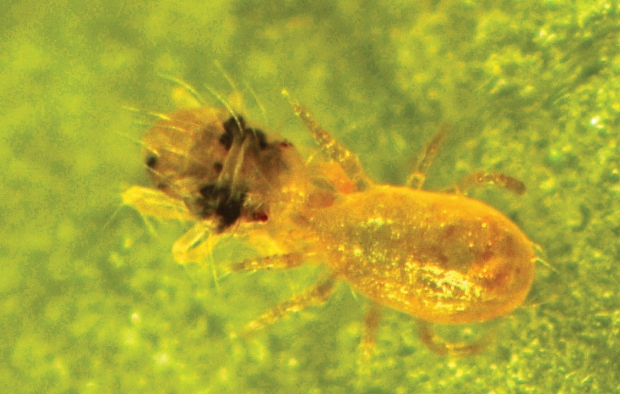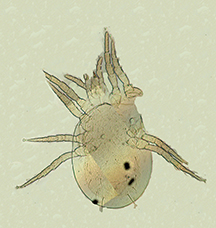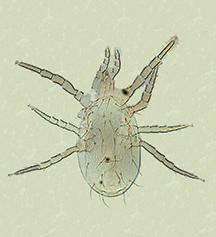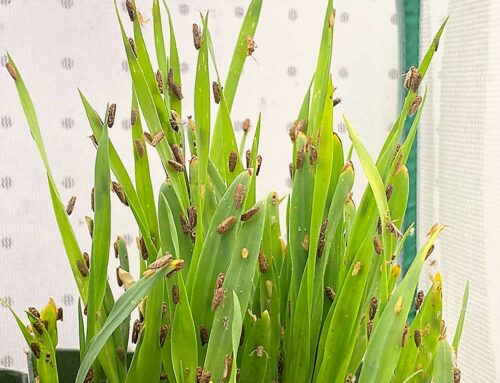
Amblydromella caudiglans eats a two-spotted spider mite. (Courtesy Washington State University)

Amblydromella caudiglans is the predominant predatory mite species in some Washington orchards.(Courtesy Washington State University)
The shift from broad-spectrum organophosphates to new classes of pesticides that are more selective appears to have caused a shift in both pest and predatory mite species in Washington orchards.
Rebecca Schmidt-Jeffris, graduate student at Washington State University in Wenatchee, found in recent studies that the little-known Amblydromella caudiglans was the predominant predatory mite in a significant number of apple orchard blocks she sampled.
Dr. Stan Hoyt, retired entomologist at WSU, developed integrated mite management during the 1960s. He found that the predatory mite Typhlodromus occidentalis (later renamed Galendromus occidentalis) was resistant to the organophosphates widely used at the time to control codling moth. With judicious use of organophosphates, growers could conserve the “typhs,” and avoid having to apply acaricides to control mites.
Schmidt-Jeffris said the most common mite species at the time was McDaniel spider mite. Since then, there’s been a gradual shift to other species, including two-spotted spider mite and rust mite.

Galendromus occidentalis, formerly known as Typhlodromus occidentalis, is the most commonly found predatory mite in Washington.(Courtesy Washington State University)
Recognizing that some of the new pesticide classes have negative effects on natural enemies, Schmidt-Jeffris decided to sample 102 commercial apple blocks throughout Washington State. Leaf samples showed that while G. occidentalis was still by far the most predominant predatory mite, A. caudiglans dominated in 20 percent of the blocks. The species has been around for a long time, but recent changes in orchard management might have given it the opportunity to flourish, she said.
Diet tests
Schmidt-Jeffris, who is working with Dr. Elizabeth Beers, did lab studies to compare the two predatory mites. She found no important differences in the life stages of the two species. However, they did have different food preferences. When served only eggs of the two-spotted spider mite, A. caudiglans ate more than did G. occidentalis. Both enjoyed spider mite protonymphs equally. But then Schmidt-Jeffris found that A. caudiglans stopped laying eggs when it was only fed two-spotted spider mites and concluded that it was not an ideal prey. It prefers European red mite, which produces less webbing than McDaniel or two-spotted spider mites.
She then asked managers of the orchard blocks she had sampled to fill out an online survey with information on the apple varieties grown, age of the block, management practices, pesticide use, prey available, and
surrounding landscape.
Where Acramite (bifenazate) and conventional pesticides were used, G. occidentalis was more plentiful. In low-input and organic blocks and those with an abundance of grass or weeds in the tree row, A. caudiglans fared better.
Schmidt-Jeffris said she was not sure why A. caudiglans liked weeds. It’s possible they provided shelter or additional resources for the mite, or it might survive better where herbicides are not used. A. caudiglans was less plentiful in Golden Delicious trees, which have smoother leaves than other varieties. Some predatory mite species prefer varieties with hairier leaves that are easier for them to cling to and reproduce on.
Pesticides
Laboratory bioassays with eight orchard pesticides showed that G. occidentalis was fairly tolerant of most pesticides except for Provado (imidacloprid) and Delegate (spinetoram) whereas A. caudiglans was susceptible to more pesticides, including Acramite, Sevin (carbaryl), Provado, and Delegate. Though Guthion (azinphos-methyl) can no longer be used, it was included in the test for comparison and proved to be much more toxic to A. caudiglans than to G. occidentalis.
Although Acramite is labeled as being safe for beneficial insects, including predatory mites, it killed 44 percent of the A. caudiglans mites. It had no effect on G. occidentalis, however. “Don’t assume that what’s good for one predator will be good for the other predator,” Schmidt-Jeffris said. •






Leave A Comment